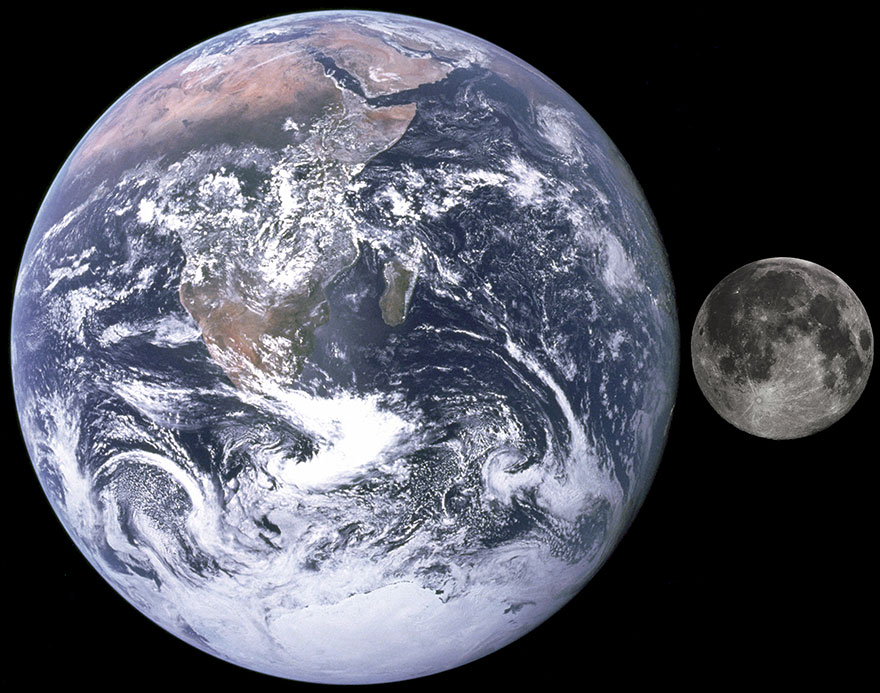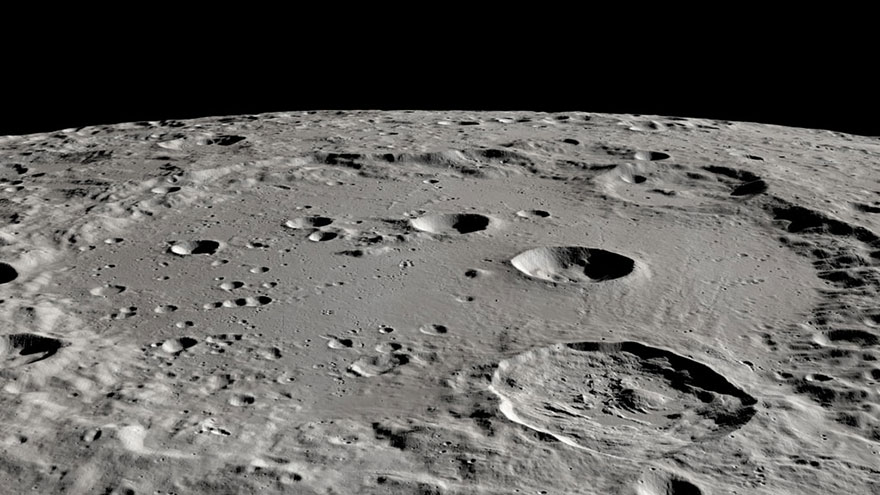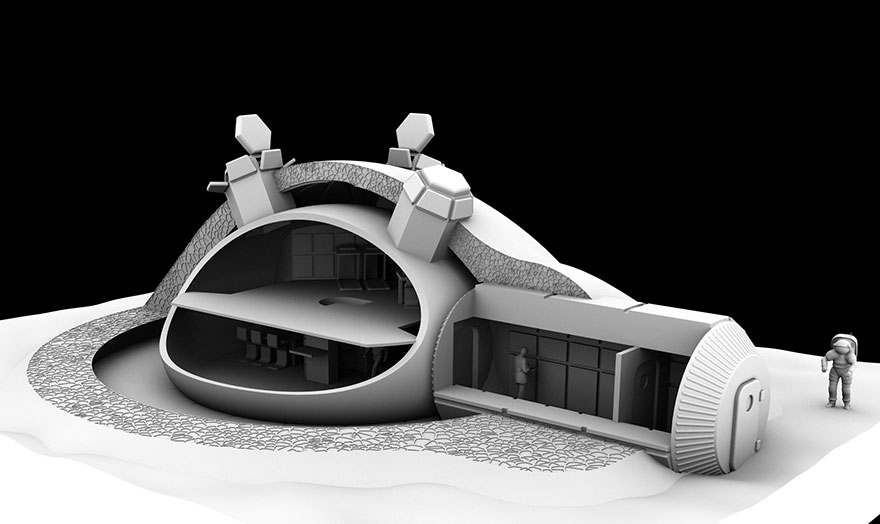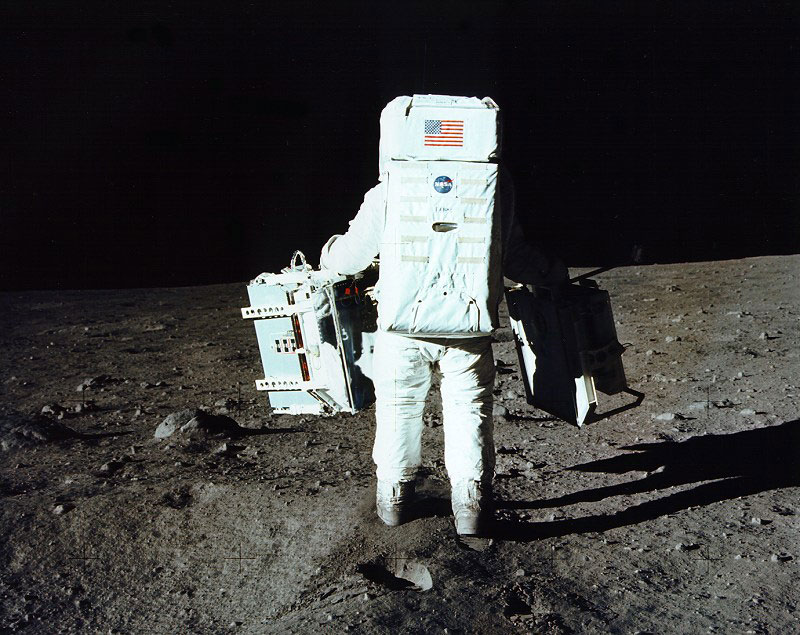The Moon, a whole new world (for educators)
On this page
When we look at the Moon in the sky, it is sometimes difficult to imagine that it is a world of its own. Although the Moon has some similarities to Earth, it is a very different world from ours, a world inhospitable to humans. Thanks in part to the Apollo missions, which enabled humans to explore it between and , we now have a better idea of its composition and the history of its formation.
Below, we present some facts about the Moon as a celestial body, its exploration and its formation, and we point out some things that young people might find confusing (!) or intriguing. (magnifying glass icon). We also provide answers to some questions that children often ask (?). Canadian contributions to lunar research and exploration are also mentioned here and there (flag icon). Many other questions and answers can be found on the page for youth.
The Moon compared with Earth

The Moon is much smaller than Earth. (Credit: Creative Commons)
The Moon is a much smaller body than Earth. The Moon is about one quarter the size of Earth. It is slightly smaller in area than North and South America combined. It also has about 81 times less mass than Earth.
Magnifying glass icon to point out things that young people might find intriguing: Show the young people images of the Moon from space or from its surface, and encourage them to compare the appearance of the Moon and Earth. They can describe in their own words the colours and textures they see on the Moon's surface. They will notice that Earth has a variety of landscapes, while the Moon is more uniform: it is all grey and rocky, with light and dark patches, and dotted with craters of various sizes. Clouds and other atmospheric phenomena change Earth's appearance on a daily basis, whereas the Moon's appearance is fairly static because it has no atmosphere.

The Moon's grey surface has many craters of all sizes. (Credit: NASA)
? : question mark: to provide answers to some questions that children often ask: How do craters form? The many craters on the Moon's surface are the result of multiple meteorite impacts. Meteorites crash into the surface at very high speeds, creating holes dozens of times larger than the rocks themselves.
! : exclamation point: to point out things that young people might find confusing: It is surprising to see so many craters on the Moon and not on Earth. In fact, Earth has also been bombarded by meteorites of all sizes, and it still is. However, the atmosphere prevents most of them from reaching the ground. In addition, geological activity, such as volcanic eruptions, plate tectonics and erosion, has continually removed the craters. Because the Moon has no atmosphere and no tectonic activity, it bears the marks of the impacts since its formation billions of years ago. A real time capsule!
? : question mark: to provide answers to some questions that children often ask: Children often wonder, "Could we live on the Moon?" This is a good opportunity to tell them about the conditions on the surface of the Moon, which are very different from conditions on Earth and do not support life without special equipment. The absence of an atmosphere, which causes extreme temperature variations (from -233 °C at night to 120 °C during the day) and offers no protection from the Sun's rays, as well as the absence of liquid water, make the Moon a completely inhospitable place for life, especially humans.
Magnifying glass icon to point out things that young people might find intriguing: The force of gravity felt at the surface of a celestial body depends on its mass and size. That is why the force of gravity on the Moon is much weaker than on Earth (about six times less). If you could go to the Moon, you would feel six times lighter!
On Earth, the terms mass and weight are often used interchangeably, but it is important to distinguish between them. The mass of a body is a property of that body; it depends on the quantity and nature of the matter it contains. The weight of a body is the force of attraction (gravity) between that body and a celestial body. So we have the same mass on Earth and the Moon, but not the same weight, since gravity is much weaker on the Moon than on Earth.
! : exclamation point: to point out things that young people might find confusing: Some people mistakenly attribute the weak gravity on the Moon to the lack of atmosphere. The gravity on the Moon would be the same even if the Moon had an atmosphere. The force of gravity we feel (our weight) depends only on the Moon's size and mass, not on the presence or absence of an atmosphere.

Artist's view of a lunar base. Even if it were pressurized and contained breathable air, the astronauts would still feel one sixth the gravity of Earth. (Credit: ESA/Foster + Partners)
Flag icon to point out Canadian contributions to lunar research and exploration: Even though the Moon is the celestial body closest to us and we have visited it several times, that does not mean we know everything about it. There are still many questions about the Moon. Canadian scientists on international teams are working to find the answers. For example, they want to know more about its surface, understand its history thanks to its craters, and determine how much water ice is available on its surface.
Lunar exploration
We know a lot more about the Moon since humans first set foot on it during the Apollo program. The first images taken from the surface of the Moon have helped us learn more about this world that is so different from Earth.
Magnifying glass icon to point out things that young people might find intriguing: Discuss with the children what they notice when they watch archival videos, like this one of two astronauts from the last Apollo mission to the Moon. How is it different from Earth? One thing that stands out is the way the astronauts bounce on the surface because the gravity is weaker there. The landscape's shades of grey and the sky's unchanging darkness are also very different. Without an atmosphere to scatter the Sun's light, the sky seen from the Moon's surface is always black, even in the daytime!

An Apollo 11 astronaut carrying scientific equipment on the Moon. (Credit: NASA)
Between and , 12 astronauts walked on the Moon, and 12 others saw the Moon up close but did not land. We often talk about the Apollo astronauts, but it is good for young people to realize that those missions, like all space missions, were the result of a huge team effort involving thousands of women and men behind the scenes.

The control center of the Apollo 11 mission, which put the first humans on the Moon. (Credit: NASA)
Among the people who worked behind the scenes were the women who worked as "computers," many of them African American. The technology back then was much less advanced than it is today, and many complex calculations were done by hand, with great precision, by those women.

Katherine Johnson was an American mathematician who worked as a "computer" early in her career. The story of Ms. Johnson and her colleagues is told in the book and movie entitled Hidden Figures. (Credit: NASA)
Magnifying glass icon to point out things that young people might find intriguing: Discuss the various aspects of space exploration (e.g. spacecraft and instrument construction, trajectory calculations, astronaut health and safety, astronaut training, communications) with the children. Have you seen any movies that focus on the behind-the-scenes work that goes into supporting a space mission? Discuss what role each child would like to play and/or thinks they have the skills for.
Flag icon to point out Canadian contributions to lunar research and exploration: A number of Canadians worked on the Apollo missions, such as William Carpentier, who was the Apollo 11 astronauts' physician. Also, a Canadian company based in Longueuil, Quebec, manufactured the landing gear for the Apollo Lunar Module.

The landing gear of the Apollo Lunar Module was designed in Canada. (Credit: NASA)
Flag icon to point out Canadian contributions to lunar research and exploration: In , Canada signed an agreement to be part of the Artemis program, which will send the next humans to the Moon, 50 years after the end of the Apollo program. The first crewed lunar mission will not land. A Canadian astronaut will be part of it and will have the opportunity to see the Moon up close. The second crewed lunar mission will land, carrying the first woman and the next man to walk on the Moon.
Canada is also contributing to Gateway, a space station that will be built in orbit around the Moon by NASA and its International Space Station partners. The Canadian contribution will be Canadarm3, a smart robotic system consisting of a large arm, a small arm and a set of detachable tools. It will be used first in the construction of the station and then for maintenance and other tasks.
Formation of the Moon
The Moon probably formed very soon after Earth formed, about 4.5 billion years ago. The most plausible theory is that there was a huge impact between Earth and a small, Mars-sized protoplanet called Theia. The collision sent a lot of debris from both celestial bodies into orbit around Earth. The Moon formed from the gradual agglomeration of that debris.

The Moon formed as a result of an impact between Earth and Theia, a protoplanet the size of Mars. (Credit: ESO/G. Glasø/M. Kornmesser)
? : question mark: to provide answers to some questions that children often ask: How do we know all that? Children often ask this question! In the case of the Moon's formation, there are clues in lunar rocks. The fact that the Moon's rocks are similar in chemical composition to Earth's rocks, but not exactly the same, tells us that the Moon was formed from debris from Earth and another body.
To capture young people's imagination, you can show them this simulation, which shows how the Moon evolved after its formation, because of meteorite impacts.
! : exclamation point: to point out things that young people might find confusing: From Earth, you can see large dark areas on the surface of the Moon called maria, which means seas in Latin. Contrary to what astronomers once believed, those areas are not bodies of water, but rather vast plains of cooled lava. They were probably created by massive bombardments of meteorites that melted part of the Moon, generating large areas of molten rock.

Artist's view of the formation of a mare (sea) during a volcanic episode caused by an intense meteorite bombardment. (Credit: NASA/Goddard Space Flight Center)

